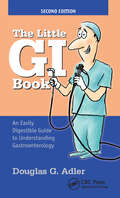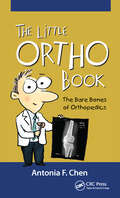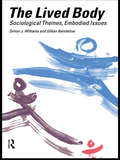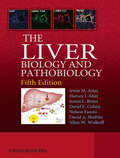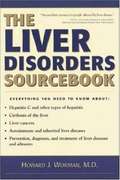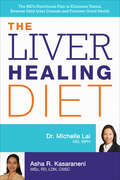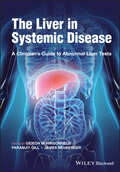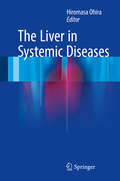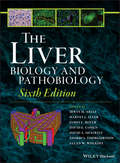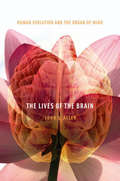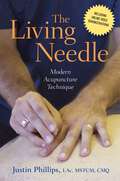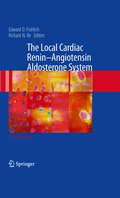- Table View
- List View
The Little Eye Book: A Pupil's Guide to Understanding Ophthalmology
by Janice K. LedfordThe Little Eye Book: A Pupil’s Guide to Understanding Ophthalmology is an easy-to-understand introduction to the field of eye care that has been updated into a new Second Edition. This book is written with the non-physician in mind, so you won’t be bogged down with heavy details, yet every basic fact that you need is right here. With photographs as well as drawings and helpful tables and charts, this conversational-style text packs a big punch. Beginning with an illustrated description of ocular anatomy, the book sweeps you into the workings of vision with hardly a blink, where you’ll learn what happens when light meets the eye. But life is never perfect, and sometimes the eye isn’t either. You’ll get a good overview of disorders and trauma, from lids to optic nerves. The all-important red eye has a section all its own, including symptoms, signs, what’s an emergency and what’s not. A chapter on eye symptoms and their potential causes will help you understand patients’ complaints.New to the Second Edition: A chapter on refractive errors and their correction, including a section on glasses and contact lenses New technology topics including optical coherence tomography, scanning laser tomography, wavefront analysis and more Updated information on medications and refractive surgery Includes over 65 figures and 10 tables Now you will finally understand how the eye works without spending hours trying to get through an overwhelming medical book. Need to know how to take a history, check vision or pupils, or give someone eye medications? It’s in here! Wonder what special testing is available? We tell you! Have questions about surgery or medical treatment? Yep, we covered that, too, and more! Written by Janice K. Ledford, an eyecare professional with over 26 years of experience, The Little Eye Book: A Pupil’s Guide to Understanding Ophthalmology, Second Edition is perfect for anyone who works in the eye care industry or with patients, but isn’t an ophthalmologist.
The Little Eye Book: A Pupil's Guide to Understanding Ophthalmology (2nd edition)
by Janice K. LedfordThis little book has much information for the non-physician, including what signs to look for, how to determine an emergency and how some medications affect the eye. The superscripted numbers indicate references at the end of the chapters.
The Little GI Book: An Easily Digestible Guide to Understanding Gastroenterology
by Douglas AdlerA practical, portable handbook, newly updated with nearly 100 color images and figures, The Little GI Book: An Easily Digestible Guide to Understanding Gastroenterology, Second Edition is an invaluable resource for anyone new to the world of gastroenterology and hepatology. Featuring new information on the latest advancements in gastroenterology and hepatology and written in a friendly, conversational style, The Little GI Book will help readers learn the core concepts of digestive health and disease and absorb important information without a hiccup. Author Dr. Douglas G. Adler provides a comprehensive, soup-to-nuts guide to gastrointestinal anatomy, physiology, disease states, and treatment. With new color images throughout, The Little GI Book guides the reader through the entire gastrointestinal tract, starting at the top with the esophagus, ending at the bottom with the colon and rectum, and covering everything in between: the stomach, small intestine, liver, pancreas, bile ducts, and gallbladder.The Little GI Book is an indispensable pocket guide for residents, students, nurse practitioners, office staff, industry sales force, and anyone who works in the GI industry but isn’t a gastroenterologist.
The Little Maverick Matchmaker (Montana Mavericks: The Lonelyhearts Ranch #3)
by Stella BagwellThe courtship of dillon’s fatherRust Creek RamblingsThe town’s new doctor, widower Drew Strickland, is dedicated to his job and to his seven-year-old son, Dillon. Young Dillon has set his sights on making pretty school librarian Josselyn Weaver a part of their family. But Drew is afraid to love again, and Josselyn fears rejection. Buckle up your backpacks, dear readers, and see if a bighearted little boy can lead his grieving dad and our favorite librarian down the path to true love!
The Little Ortho Book: The Bare Bones of Orthopedics
by Antonia ChenThe Little Ortho Book: The Bare Bones of Orthopedics is a pocket-sized, easy-to-understand introduction into the field of orthopedics. Written with the non-physician in mind, The Little Ortho Book provides the basics of orthopedics for residents, medical students, front office staff, and industry sales force. Dr. Antonia Chen takes complicated orthopedic terms and conditions and explains them in ways that are understandable to all. By focusing on common orthopedic diagnoses and relevant anatomy, The Little Ortho Book: The Bare Bones of Orthopedics answers the questions that arise from orthopedic conditions in user-friendly language that is understandable to everyone. Portable and handy and supplemented with images and diagrams, this conversational-style book packs a big punch!What is Inside:• Descriptions of joint biomechanics and bone and muscle composition• Commonly performed exams are explained with a description of the condition being tested• Sports injuries, fractures, arthritis, and orthopedic conditions in children • Description of medications that are commonly prescribed in orthopedics• Commonly performed orthopedic surgeries, including indications for surgery and descriptions of the procedures performed – all described in simplistic detailThe Little Ortho Book: The Bare Bones of Orthopedics is an easy-to-read resource for a wide variety of audiences who work in the orthopedic industry or with orthopedic patients, but isn’t an orthopedic surgeon.
The Lived Body: Sociological Themes, Embodied Issues
by Simon J. Williams Gillian A. BendelowThe Lived Body takes a fresh look at the notion of human embodiment and provides an ideal textbook for undergraduates on the growing number of courses on the sociology of the body.The authors propose a new approach - an 'Embodied Sociology' - one which makes embodiment central rather than peripheral. They critically examine the dualist legacies of the past, assessing the ideas of a range of key thinkers, from Marx to Freud, Foucault to Giddens, Deleuze to Guattari and Irigary to Grosz, in terms of the bodily themes and issues they address.They also explore new areas of research, including the 'fate' of embodiment in late modernity, sex, gender, medical technology and the body, the sociology of emotions, pain, sleep and artistic representations of the body.The Lived Body will provide students and researchers in medical sociology, health sciences, cultural studies and philosophy with clear, accessible coverage of the major theories and debates in the sociology of the body and a challenging new way of thinking.
The Lived Experience in Mental Health
by Gary MorrisThe importance of recognising the knowledge and the needs of service users and engaging them more proactively within the care process is now widely acknowledged, but it is not always clear how this can come about. The Lived Experience of Mental Health highlights individuals’ own lived and felt mental health experience in order to share their expertise about mental health problems and the care offered. This text begins by exploring the importance of engaging with the internal world of those living with various mental health problems and reflecting upon personal narratives as means of expressing and sharing experience, as well as the status of these narratives as 'evidence'. The central section of the book looks at five commonly experienced mental health states: anxiety problems, depression, mood extremes, states of altered reality (linked, for example, with psychosis and schizophrenia) and impaired cognition (linked, for example, with dementia). The chapters look at how the mental state in question is experienced, including the experience of it in the context of the wider world, where health and social care services and the responses of other people play a part. Drawing on personal narratives from a wide range of sources, this text foregrounds the voices of experts by experience and relates them to the academic literature. The narratives collectively convey a breadth of experience including both concepts of struggling and living well with mental health issues. The book ends by outlining resources where a range of first-person narratives can be accessed, from online forums to films, and providing a strategy for teaching and learning associated with the exploration of lived experience narratives. Designed for health professionals working with people experiencing mental health problems, this illuminating text uses personal narratives to emphasise the importance of person-centred care and participation by services users in their own care. It will also be an interesting read for experts by experiences themselves as well as their families and friends.
The Liver
by David Cohen Harvey Alter David Shafritz Nelson Fausto Irwin Arias James Boyer Allan WolkoffIn its Fifth Edition, this classic book retains its traditional strength of relating molecular physiology to understanding disease pathology and treatment as it explores the current state and future direction of hepatology.Painstakingly revised, this edition includes 60 new chapters. As in previous editions, a section called Horizons summarizes advances of extraordinary nature in areas expected to have a substantial impact on hepatology. The Fifth Edition's Horizons section includes emerging topics such as tissue engineering of the liver, liver-directed gene therapy, decoding the liver cancer genome, and imaging cellular proteins and structure.To preserve essential background information which has not changed while making room for the panoply of major new contributions to understanding of liver disease, 14 chapters from the previous edition are freely available online at gastrohep.com. To view these chapters visit - http://www.gastrohep.com/theliver/
The Liver Disorders Sourcebook
by Howard J. WormanThis book gives all-inclusive information on the symptoms, therapies, and prevention of liver diseases.
The Liver Healing Diet: The MD's Nutritional Plan to Eliminate Toxins, Reverse Fatty Liver Disease and Promote Good Health
by Michelle Lai Asha KasaraneniThe first book to provide you with a detailed program for reversing liver damage through optimal nutrition—from two of the country’s top liver specialists.The only organ in your body that regenerates itself is the liver. And now, you can make it happen. With a complete program to rejuvenate your liver through optimal nutrition and routine exercise, The Liver Healing Diet shows you how to:Improve liver functionBeat fatty liver diseaseDetoxify the liverBoost all-around healthNourish the body with delicious recipesThe Liver Healing Diet teaches you basic liver facts, how to talk to your doctor about liver disease and what steps you need to reverse years of abuse. With your newly repaired liver you’ll feel better, have more energy and live a healthy lifestyle.
The Liver in Systemic Disease: A Clinician's Guide to Abnormal Liver Tests
by Gideon M. Hirschfield James Neuberger Paramjit GillThe Liver in Systemic Disease A practical guide for non-hepatologists who encounter abnormal liver test results in patients The Liver in Systemic Disease is an easy-to-use and authoritative guide for non-hepatologist health care professionals who need guidance on the management of patients with abnormal liver tests. The book provides definitive advice for when further investigation, or changes in management, are indicated. With a practical focus throughout the text, the editors explore when and how to investigate and manage patients whose primary disease is non-hepatic, but whose liver tests are unexpectedly abnormal. The Liver in Systemic Disease provides substantial flow diagrams and advice on the process, together with updates on the liver diseases non-hepatologists are most likely to encounter. Take-home primers included in the book shine a light on best practice and recommended procedures when dealing with abnormal liver test results. The book also provides: A thorough introduction to evaluate the liver, including serum liver tests, liver imaging, and liver biopsy Comprehensive discussions of practical issues in patients with liver abnormalities, including the diagnosis of drug induced liver injury, prescribing in patients with abnormal liver tests, and more Practical discussions of the management of patients with unexplained abnormal liver tests in primary care In-depth examinations of secondary care management of patients with unexplained abnormal liver tests, including intensive care, and the care of infectious and immunosuppressed patients The Liver in Systemic Disease is an indispensable resource for non-hepatologist medical practitioners seeking to understand the implications of abnormal liver tests and who wish to know when further investigation or alteration of management is indicated.
The Liver in Systemic Diseases
by Hiromasa OhiraBased on the results of studies on autoimmunity, the endocrine system, nutrients, metal metabolism and intestinal bacterial flora, this volume thoroughly covers studies on functional correlation of the liver with the spleen, visceral fat, intestinal tract, and central nervous system. Including associations with dysbiosis, nonalcoholic steatohepatitis (NASH) and hepatocellular carcinoma, it offers comprehensive data on correlations of organs with the liver from basic and clinical viewpoints. The Liver in Systemic Diseases will especially be of interest to researchers, clinical residents and medical students with an interest in hepatology and gastroenterology. Furthermore, the book has interdisciplinary appeal and provides a foundation that will help physicians to consider clinical conditions of diseases from a broader perspective.
The Liver: Biology and Pathobiology
by Snorri S. Thorgeirsson Irwin M. Arias Allan W. Wolkoff James L. Boyer David A. Shafritz Harvey J. Alter David E. CohenBridging the gap between basic scientific advances and the understanding of liver disease — the extensively revised new edition of the premier text in the field. The latest edition of The Liver: Biology and Pathobiology remains a definitive volume in the field of hepatology, relating advances in biomedical sciences and engineering to understanding of liver structure, function, and disease pathology and treatment. Contributions from leading researchers examine the cell biology of the liver, the pathobiology of liver disease, the liver’s growth, regeneration, metabolic functions, and more. Now in its sixth edition, this classic text has been exhaustively revised to reflect new discoveries in biology and their influence on diagnosing, managing, and preventing liver disease. Seventy new chapters — including substantial original sections on liver cancer and groundbreaking advances that will have significant impact on hepatology — provide comprehensive, fully up-to-date coverage of both the current state and future direction of hepatology. Topics include liver RNA structure and function, gene editing, single-cell and single-molecule genomic analyses, the molecular biology of hepatitis, drug interactions and engineered drug design, and liver disease mechanisms and therapies. Edited by globally-recognized experts in the field, this authoritative volume: Relates molecular physiology to understanding disease pathology and treatment Links the science and pathology of the liver to practical clinical applications Features 16 new “Horizons” chapters that explore new and emerging science and technology Includes plentiful full-color illustrations and figures The Liver: Biology and Pathobiology, Sixth Edition is an indispensable resource for practicing and trainee hepatologists, gastroenterologists, hepatobiliary and liver transplant surgeons, and researchers and scientists in areas including hepatology, cell and molecular biology, virology, and drug metabolism.
The Lives They Left Behind
by Robert Whitaker Darby Penney Peter Stastny Lisa Rinzler"The Lives They Left Behind is a deeply moving testament to the human side of mental illness, and of the narrow margin which so often separates the sane from the mad. It is a remarkable portrait, too, of the life of a psychiatric asylum--the sort of community in which, for better and for worse, hundreds of thousands of people lived out their lives. Darby Penney and Peter Stastny's careful historical (almost archaeological) and biographical reconstructions give us unique insight into these lives which would otherwise be lost and, indeed, unimaginable to the rest of us."--Oliver Sacks, M.D., Professor of Neurology and Psychiatry, Columbia University Medical Center, Columbia University Artist, and author of Musicophilia "The haunting thing about the suitcase owners is that it's so easy to identify with them."--Newsweek "In their poignant detail the items helped rescue these individuals from the dark sprawl of anonymity."--The New York Times "[The authors] spent 10 years piecing together . . . the lives these patients lived before they were nightmarishly stripped of their identities."--Newsday More than four hundred abandoned suitcases filled with patients' belongings were found when Willard Psychiatric Center closed in 1995 after 125 years of operation. They are skillfully examined here and compared to the written record to create a moving--and devastating--group portrait of twentieth-century American psychiatric care.
The Lives They Left Behind: Suitcases from a State Hospital Attic
by Darby Penney Peter StastnyThis book grew out of ten years of research conducted by two journalists who discovered a trove of abandoned trunks and suitcases in an attic at Willard State Hospital in New York. Through extensive research they were able to reconstruct the histories of ten patients who were hospitalized at Willard during the years before deinstitutionalization. Through the microcosm of individual lives the authors humanize the tragedy of our treatment of people deemed to be mentally ill.
The Lives of the Brain: Human Evolution And The Organ Of Mind
by John S. AllenThough we have other distinguishing characteristics (walking on two legs, for instance, and relative hairlessness), the brain and the behavior it produces are what truly set us apart from the other apes and primates. And how this three-pound organ composed of water, fat, and protein turned a mammal species into the dominant animal on earth today is the story John S. Allen seeks to tell.
The Living Kitchen: Healing Recipes to Support Your Body During Cancer Treatment and Recovery
by Tamara Green Sarah GrossmanFrom two experts in cancer care cooking comes an informative, inspiring and empowering guide that will educate cancer patients and their caregivers about the healing power of food.With nearly 100 recipes - all stress-free, healthy, freezer-friendly and flavorful - specially designed to relieve specific symptoms and side effects of cancer and its therapies (including loss of appetite, sore mouth, altered taste buds, nausea, and more) and to strengthen your body once in recovery, The Living Kitchen is accompanied by stunning photography and a simple, user-friendly design. In this indispensable guide, certified nutritionists Sarah Grossman and Tamara Green provide easy-to-understand, research-based nutritional information on the science of how food relates to your health and the effects of cancer, and offer strategies to prepare your body, life and kitchen for treatment.You will find recipes for:- Energising snacks and breakfasts- Superfood smoothies, juices and elixirs- Soups and stews- Nutrient-rich, delicious main dishesThese are recipes that you, your family, and your caregivers will all enjoy. The Living Kitchen will give you comfort in knowing that your body will be nourished and supported during (and even after) cancer treatment.A cancer diagnosis can be overwhelming, frightening and uncertain. You'll want to learn what to expect from chemotherapy and radiation, how you'll navigate the often debilitating side effects that come with treatment, and what you should eat to support your body at a time when eating and cooking may be too challenging. The Living Kitchen will help cancer patients and their caregivers navigate every stage of their cancer therapy journey, from diagnosis to treatment to recovery.
The Living Medicine: How a Lifesaving Cure Was Nearly Lost—and Why It Will Rescue Us When Antibiotics Fail
by Lina ZeldovichA remarkable story of the scientists behind a long-forgotten and life-saving cure: the healing viruses that can conquer antibiotic resistant bacterial infectionsFirst discovered in 1917, bacteriophages—or “phages”—are living medicines: viruses that devour bacteria. Ubiquitous in the environment, they are found in water, soil, inside plants and animals, and in the human body.When phages were first recognized as medicines, their promise seemed limitless. Grown by research scientists and physicians in France, the Soviet Union, and elsewhere to target specific bacteria, they cured cholera, dysentery, bubonic plague, and other deadly infectious diseases.But after Stalin’s brutal purges and the rise of antibiotics, phage therapy declined and nearly was lost to history—until today. In The Living Medicine, acclaimed science journalist Lina Zeldovich reveals the remarkable history of phages, told through the lives of the French, Soviet, and American scientists who discovered, developed, and are reviving this unique cure for seemingly-intractable diseases. Ranging from Paris to Soviet Georgia to Egypt, India, Kenya, Siberia, and America, The Living Medicine shows how phages once saved tens of thousands of lives. Today, with our antibiotic shield collapsing, Zeldovich demonstrates how phages are making our food safe and, in cases of dire emergency, rescuing people from the brink of death. They may be humanity’s best defense against the pandemics to come.Filled with adventure, human ambition, tragedy, technology, irrepressible scientists and the excitement of their innovation, The Living Medicine offers a vision of how our future may be saved by knowledge from the past.
The Living Needle: Modern Acupuncture Technique
by Justin PhillipsThis fully illustrated guide to modern acupuncture technique explores the foundational skills of the craft from a primarily energetic perspective, showing how perfecting these skills can have a profound effect on the practice of Chinese Medicine. The goal is for the clinician to be able to fully grasp what they are doing on the channels and the tissues with each of the classic manipulation techniques in a way that has hitherto been unexplored in technique textbooks, which tend to focus on the simple mechanics of technique. Organised around the structure of an actual patient encounter, the book begins with the basics of needle selection, moving through patient and practitioner position, to insertion, and then on to the various mechanical actions taken on an inserted needle, ending with the withdrawal of the needle. The skills discussed and described in this book can help expand any acupuncturist's practice through their application. Further advice and information is provided through supplementary online video demonstrations.
The Living Well with Dementia Course: A Workbook for Facilitators
by Richard Cheston Ann MarshallThe Living Well with Dementia Course: A Workbook for Facilitators will be an indispensable guide to providing support to people after they have received a dementia diagnosis. The workbook provides facilitators with a realistic but positive approach to helping people with dementia understand and adjust to their condition, helping them to live as well as possible. This workbook outlines the Living Well with Dementia course, a post-diagnostic course for people who have recently received a diagnosis of dementia. Its session-by-session structure, along with e-resources including handouts for course participants, will help facilitators provide a realistic but positive approach to support after a diagnosis. Aimed at facilitators, and drawing on the authors’ many years of clinical and research experience, The Living Well with Dementia Course workbook will be of great assistance to healthcare professionals and support workers in many different settings, including specialist NHS dementia services, primary care services and the voluntary and community sector.
The Local Cardiac Renin-Angiotensin Aldosterone System
by Richard N. Re Edward D. FrohlichUntil recently, the renin-angiotensin-aldosterone system has been considered a systemic endocrine hormonal system exclusively. It is now known that each component of the renin-angiotensin system is produced, synthesized and indeed, present in many organisms including the heart and vessels. This volume presents the most recent clinical and laboratory experiences of the leading physicians and investigators in the field of the local cardiac renin-angiotensin aldosterone system. Cardiovascular, renal and hypertension oriented physicians, investigators and scientists would find this book of interest. Edward D. Frohlich, M.D., M.A.C.P, F.A.C.C., is the Alton Ochsner Distinguished Scientist at the Ochsner Clinic Foundation in New Orleans, Louisiana. He is also Professor of Medicine and of Physiology at Louisiana State University School of Medicine, New Orleans, and Clinical Professor of Medicine and Adjunct Professor of Pharmacology at Tulane University School of Medicine, New Orleans. He is past Editor-in-Chief of the American Heart Association journal HYPERTENSION. Richard N. Re, M.D., is the Section Head, Hypertension at the Ochsner Clinic Foundation in New Orleans, Louisiana. He is also Ochsner's Scientific Director of Research.
The Lock In Series: Lock In, Head On, Unlocked
by John ScalziThis discounted ebundle includes: Lock In, Head On, Unlocked"This is the kind of thriller that Michael Crichton, Lincoln Child, and James Rollins do so well. Add John Scalzi to that list." --Douglas PrestonA blazingly inventive near-future thriller series from the best-selling, Hugo Award-winning John Scalzi.Not too long from today, a new, highly contagious virus makes its way across the globe. Most who get sick experience nothing worse than flu, fever and headaches. But for the unlucky one percent -- and nearly five million souls in the United States alone -- the disease causes "Lock In": Victims fully awake and aware, but unable to move or respond to stimulus. The disease affects young, old, rich, poor, people of every color and creed. The world changes to meet the challenge.At the Publisher's request, this title is being sold without Digital Rights Management Software (DRM) applied.
The Lock and Key of Medicine
by Lara V. MarksThis book is the first to tell the extraordinary yet unheralded history of monoclonal antibodies. Often referred to as Mabs, they are unfamiliar to most nonscientists, yet these microscopic protein molecules are everywhere, quietly shaping our lives and healthcare. Discovered in the mid-1970s in the laboratory where Watson and Crick had earlier unveiled the structure of DNA, Mabs have radically changed understandings of the pathways of disease. They have enabled faster, cheaper, and more accurate clinical diagnostic testing on a vast scale. And they have played a fundamental role in pharmaceutical innovation, leading to such developments as recombinant interferon and insulin, and personalized drug therapies such as Herceptin. Today Mabs constitute six of the world's top ten blockbuster drugs and make up a third of new introduced treatments. Lara V. Marks recounts the risks and opposition that a daring handful of individuals faced while discovering and developing Mabs, and she addresses the related scientific, medical, technological, business, and social challenges that arose. She offers a saga of entrepreneurs whose persistence and creativity ultimately changed the healthcare landscape and brought untold relief to millions of patients. Even so, as Marks shows, controversies over Mabs remain, and she examines current debates over the costs and effectiveness of these innovative drugs.
The Locked Ward: A humane and revealing account of life on the frontlines of mental health care.
by Dennis O'DonnellAn extraordinary account of life behind the locked doors of a secure psychiatric ward from a nurse who worked there for seven years. Dennis O'Donnell started work as an orderly in the Intensive Psychiatric Care Unit of a large hospital in Scotland in 2000. In his daily life he encountered fear, violence and despair but also a considerable amount of care and compassion. Recounting the stories of the patients he worked with, and those of his colleagues on the ward, here he examines major mental health conditions, methods of treatment - medication, how religion, sex, wealth, health and drugs can bear influence on mental health, the prevailing attitudes to psychiatric illness, the authorities, the professionals & society. What emerges is a document of humanity and humour, a remarkable memoir that sheds light on a world that still remains largely unknown. 'This is a superb study of people whose minds have gone wrong, and the art of caring for them' Evening Standard
The Locus of Care: Families, Communities, Institutions, and the Provision of Welfare Since Antiquity (Routledge Studies in the Social History of Medicine)
by Peregrine Horden and Richard SmithThe care of the needy and the sick is delivered by various groups including immediate family, the wider community, religious organisations and the State funded institutions. The Locus of Care provides an historical perspective on welfare detailing who carers were in the past, where care was provided, and how far the boundary between family and state or informal and organised institutions have changed over time. Eleven international contributors provide a wide-ranging examination of themes, such as child care, mental health, and provision for the elderly and question the idea that there has been a recent evolutionary shift from informal provision to institutional care. Chapters on Europe and England use case studies and link evidence from ancient and medieval periods to contemporary problems and the recent past, whilst studies on China and South Africa look to the future of welfare throughout the world. By placing welfare in its historical, social, cultural and demographic contexts, Locus of Care reassesses community and institutional care and the future expectations of welfare provision.


